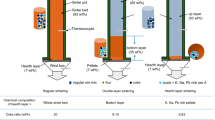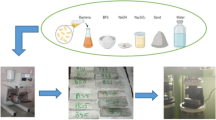Abstract
This paper investigated the influence of silica fume on radioactive fluoride concentrate liquid waste cementation with magnesium potassium phosphate cement (MKPC). The results showed that when the silica fume mass fraction increased from 0 to 20%, the setting time and fluidity of the MKPC slurry decreased, while the 28-day compressive strength of the solidified form increased. The main hydration products were MgKPO4·6H2O and magnesium silicate hydrate (M–S–H). Silica fume had good physical adsorption of cesium, whose 42-day cumulative leaching fraction decreased from 0.083 ± 0.003 to 0.044 ± 0.002 cm. The formation of magnesium fluosilicate and its hydrate led to a decrease of fluorine leaching.







Similar content being viewed by others
References
Sun Y-P, Xia X-B, Qiao Y-b et al (2016) Properties of phosphate glass waste forms containing fluorides from a molten salt reactor. J Nucl Sci Technol 27(3):89–95
Siemer DD (2014) Molten salt breeder reactor waste management. Nucl Technol 185(1):100–108
Wagh AS, Jeong SY (2003) Chemically bonded phosphate ceramics: I, A dissolution model of formation. J Am Ceram Soc 86(11):1838–1844
Rouzic ML, Chaussadent T et al (2017) Mechanisms of k-struvite formation in magnesium phosphate cements. Cem Concr Res 91:117–122
Soudée E, Péra J (2000) Mechanism of setting reaction in magnesia phosphate cements. Cem Concr Res 30(2):315–321
Yang Q-B, Xue-li Wu (1999) Factors influencing properties of phosphate cement-based binder for rapid repair of concrete. Cem Concr Res 29(3):389–396
Wagh AS, Strain R, Jeong SY et al (1999) Stabilization of Rocky Flats Pu-contaminated ash within chemically bonded phosphate ceramics. J Nucl Mater 265:295–307
Vinokurov SE, Kulikova SA, Myasoedov BF (2018) Hydrolytic and thermal stability of magnesium potassium phosphate compound for immobilization of high level waste. J Radioanal Nucl Chem 318:2401–2405
Vinokurov SE, Kulikova SA, Krupskaya VV, Myasoedov BF (2018) Magnesium potassium phosphate compound for radioactive waste immobilization: phase composition, structure, and physicochemical and hydrolytic durability. Radiochemistry 60:70–78
Covill A, Hyatt NC, Hill J et al (2011) Development of magnesium phosphate cements for encapsulation of radioactive waste. Adv Appl Ceram 110(3):151–156
Buj I, Torras J et al (2010) Leaching behavior of magnesium phosphate cements containing high quantities of heavy metals. J Hazard Mater 175(1):789–794
Cantrell KJ, Um W et al (2014) Chemical stabilization of Hanford tank residual waste. J Nucl Mater 446:246–256
Mao M, Wang Z, Jia X-W (2012) Researching on water resistance improvement of magnesium phosphate cement. Non-Metallic Mines 35(6):1–3
Huang Y-X, Qian J-S, Wang Q-Z et al (2011) Influence of fly ash on water resistance of magnesia phosphate cement. Mater Rev 25(1):470–473
Zheng D-D, Ji T, Wang C-Q (2016) Effect of the combination of fly ash and silica fume on water resistance of Magnesium–Potassium Phosphate Cement. Constr Build Mater 106:415–421
Chen B, Zhen Wu, Xue-ping Wu (2011) Experimental research on the properties of modified MPC. J Wuhan Univ Technol 33(4):29–34
Fei Qiao CK, Chau Z-J (2012) Calorimetric study of magnesium potassium phosphate cement. Mater Struct 45(3):447–456
Ma H-Y, Bi-wan Xu (2017) Potential to design magnesium potassium phosphate cement paste based on an optimal magnesia-to-phosphate ratio. Mater Des 118:81–88
Lai Z-y, Lai X-C, Shi J-B et al (2016) Effect of Zn2+ on the early hydration behavior of potassium phosphate based magnesium phosphate cement. Constr Build Mater 129:70–78
Qian Z-H, Liu X-Y, Qiao Y-b et al (2019) Effect of fluorine on stabilization/solidification of radioactive fluoride liquid waste in magnesium potassium phosphate cement. J Radioanal Nucl Chem 319:393–399
Sarkar AK (1991) Hydration\dehydration characteristics of struvite and dittmarite pertaining to magnesium ammonium phosphate cement system. J Mater Sci 26:2514–2518
Zhang T, Cheeseman CR, Vandeperre LJ (2011) Development of low pH cement systems forming magnesium silicate hydrate (MSH). Cem Concr Res. 41(4):439–442
Bernard E, Lothenbach B, Chlique C et al (2019) Characterization of magnesium silicate hydrate (M–S–H). Cem Concr Res 116:309–330
Zhang T-T, Zou J, Wang B-M et al (2018) Characterization of magnesium silicate hydrate (MSH) gel formed by reacting mgo and silica fume. Materials 11:909
Ting-ting Zhang LJ, Vandeperre CR, Cheeseman, (2014) Formation of magnesium silicate hydrate (M–S–H) cement pastes using sodium hexametaphosphate. Cem Concr Res 65:8–14
GB/T 7023-2011 (2011) Standard test method for leachability of low and intermediate level solidified radioactive waste forms. Chinese standard
Asabina EA, Zaripov AR, Petkov VI et al (2008) Thermodynamic properties of caesium-magnesium monophosphate. J Chem Thermodyn 40(4):653–660
Acknowledgements
This work was supported by “Young Potential Program of Shanghai Institute of Applied Physics, Chinese Academy of Sciences” (Y955031031) and “Shanghai Sailing Program” (19YF1458100).
Author information
Authors and Affiliations
Corresponding author
Additional information
Publisher's Note
Springer Nature remains neutral with regard to jurisdictional claims in published maps and institutional affiliations.
Rights and permissions
About this article
Cite this article
Qian, Zh., Yu, Bw., Zhou, S. et al. Influence of silica fume on radioactive fluoride concentrate liquid waste solidified by magnesium potassium phosphate cement. J Radioanal Nucl Chem 324, 1013–1019 (2020). https://doi.org/10.1007/s10967-020-07151-3
Received:
Published:
Issue Date:
DOI: https://doi.org/10.1007/s10967-020-07151-3




